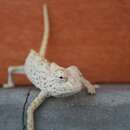Biology
provided by Arkive
Living in such an inhospitable environment, the Namaqua chameleon's body and behaviour have evolved to keep it from overheating. It digs holes in the sand to reach the cooler sand beneath, or may hide in burrows built by other animals. It will also stand on straightened legs to lift its body off the hot sand, a behaviour known as 'stilting'. The nasal glands are adapted to excrete salt, allowing the Namaqua chameleons to reabsorb as much water as possible (3).
The Namaqua chameleon is an extremely fast runner, and uses its lengthy tongue to catch anything small enough to swallow, including locusts, crickets, beetles, small snakes, and poisonous scorpions. It is preyed upon by hawks, eagles and jackals. Adult Namaqua chameleons may even cannibalise smaller individuals of the same species (2).
Mating can take place up to three times a year, producing between 6 and 22 eggs in each clutch. The eggs incubate for three to four months in the sand, and females are thought to guard the laying site. Young Namaqua chameleons become reproductively active between five and seven months old (3).
Conservation
provided by Arkive
Through being listed on Appendix II of CITES, the Namaqua chameleon cannot be exported without a permit and the number exported is controlled by quotas (1).
Description
provided by Arkive
A unique family of lizards, chameleons exhibit some bizarre traits. With a large, triangular head, conical, independently-moving eyes, laterally compressed body and fused toes, the chameleon has looks as strange as its behaviour. All chameleon species are capable of colour change, which is not only for camouflage as is generally assumed. Chameleons may also change colour in response to other chameleons (when fighting or mating), temperature, and their surroundings. Particularly comical when walking, they have an odd gait, moving with diagonally opposite limbs. The toes are fused, giving mitten-like feet that are efficient for gripping branches in many habitats occupied by chameleon species. The tongue may be up to twice the length of the body, with a bulbous sticky tip, which it shoots out to capture its prey (4). Normally, the Namaqua chameleon is grey and brown with four to six lighter patches on its sides, dark triangles beneath the dorsal crest and red or yellow stripes on the throat. This species has a large head, a dorsal crest and a short tail which is not prehensile as it is in arboreal chameleon species (3).
Habitat
provided by Arkive
Occurs in desert and semi-desert regions, with low rainfall and temperatures ranging from 0 ºC to 40 ºC (3).
Range
provided by Arkive
The Namaqua chameleon is found in an area known as Namaqualand in western South Africa, as well as in Angola and the Namib Desert of Namibia (1) (3).
Status
provided by Arkive
The Namaqua chameleon is listed on Appendix II of CITES (1).
Threats
provided by Arkive
The intriguing and appealing appearance and behaviour of chameleons makes them particularly susceptible to collection for the pet trade, and this species is no exception. Relative to other chameleon species, however, its habitat is particularly inaccessible, protecting this species from total exploitation (4).

